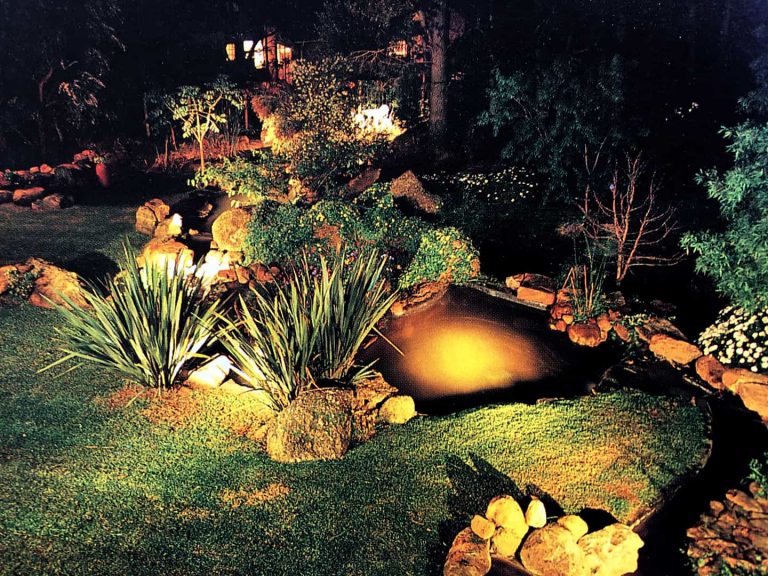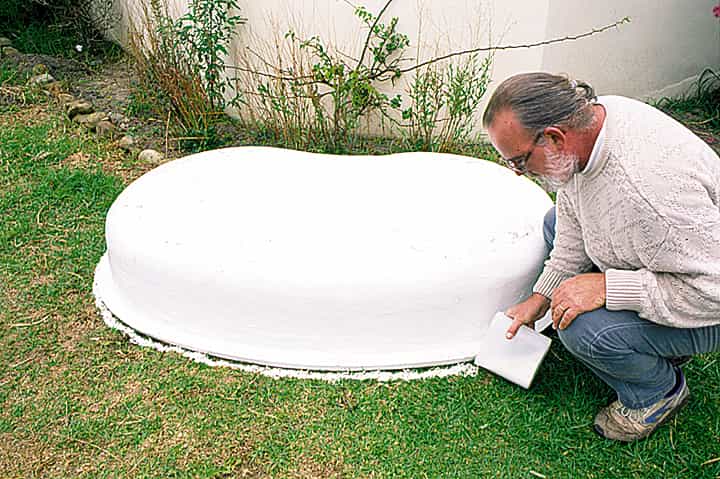
We Will Explore Some Common Pond Problems
Main Pic above: “You do not want your pond to look like this!”
Ponds are delightful water features that add beauty, tranquility, and a touch of nature to any outdoor space. However, like any aspect of landscaping, ponds can encounter issues that need to be addressed for their continued health and aesthetic appeal. In this guide, we will explore some common pond problems and provide solutions to help you maintain a thriving and beautiful pond.
1: Water Quality Issues
One of the most common pond problems is related to water quality. Poor water quality can lead to a variety of issues, including algae blooms, fish stress, and plant decline.
1. Algae Blooms
Pond Problem: Algae blooms can quickly overtake a pond, turning the water green and reducing its clarity.
Solution:
Aeration: Install aeration equipment like fountains or diffusers to improve oxygen levels, which can help control algae growth.
Add Beneficial Bacteria: Introduce beneficial bacteria that can compete with algae for nutrients, reducing their ability to grow.
Shade: Add aquatic plants to provide natural shade and reduce sunlight penetration into the water.
2. Low Oxygen Levels
Pond Problem: Low oxygen levels can stress fish and lead to poor water quality.
Solution:
Aeration: Use aeration systems to increase oxygen levels in the pond.
Remove Debris: Clear debris and organic matter from the pond to prevent the buildup of organic material that consumes oxygen.
Reduce Fish Population: If the pond is overcrowded with fish, consider thinning the population to maintain healthy oxygen levels.
3. High Nutrient Levels
Pond Problem: Excess nutrients, such as phosphates and nitrates, can lead to algae blooms and poor water quality.
Solution:
Plant Aquatic Vegetation: Add a variety of aquatic plants to help absorb excess nutrients and maintain water quality.
Control Runoff: Prevent excess nutrients from entering the pond by managing runoff from lawns and gardens.
Use Barley Straw: Barley straw can help reduce nutrient levels naturally and control algae growth.
2: Algae and Weed Overgrowth
Uncontrolled algae and weed growth can overwhelm your pond, making it less visually appealing and disrupting the ecosystem.
1. Blanket Weed or String Algae
Pond Problem: Blanket weed, also known as string algae, can cover the surface of the pond and choke out other plants.
Solution:
Manual Removal: Gently pull out the blanket weed by hand or use a long stick or pole to wrap and remove it.
Barley Straw: Use barley straw, which can help control blanket weed growth over time.
Beneficial Bacteria: Add beneficial bacteria to the pond to help break down excess nutrients and reduce algae.
2. Duckweed and Watermeal
Pond Problem: Duckweed and watermeal are tiny floating plants that can cover the surface of the pond.
Solution:
Skim the Surface: Use a fine net or skimmer to remove duckweed and watermeal regularly.
Increase Aeration: Improve water circulation to prevent these plants from forming dense mats on the surface.
Add Floating Plants: Introduce floating plants like water lilies to provide competition for light and nutrients.
3. Submerged Aquatic Weeds
Pond Problem: Submerged aquatic weeds can grow beneath the surface and disrupt the pond’s balance.
Solution:
Mechanical Removal: Use rakes or weed cutters to physically remove submerged weeds.
Use Barriers: Install physical barriers or screens to prevent the growth of submerged aquatic plants in specific areas.
Herbicides: In severe cases, consider using herbicides that are safe for aquatic use and follow the manufacturer’s instructions carefully.
3: Wildlife Issues
Ponds often attract various forms of wildlife, which can be delightful, but they can also bring problems.
1. Predators
Pond Problem: Birds, raccoons, and other animals may prey on your fish.
Solution:
Add Netting: Cover the pond with netting or wire mesh to prevent animals from accessing the fish.
Create Hiding Places: Use submerged structures or aquatic plants to provide hiding places for fish.
Install Motion-Activated Devices: Motion-activated sprinklers or lights can deter unwanted wildlife.
2. Invasive Species
Pond Problem: Invasive species of plants or animals can disrupt the ecosystem and outcompete native species.
Solution:
Regular Inspection: Regularly inspect your pond for signs of invasive species and remove them promptly.
Plant Natives: Choose native plants to help maintain a balanced ecosystem.
Consult Professionals: If you suspect a serious invasive species issue, consult with a local pond management professional.
4: Maintenance Challenges
Proper maintenance is vital for a healthy pond, and neglecting it can lead to a range of problems.
1. Debris Accumulation
Pond Problem: Leaves, twigs, and other organic debris can accumulate on the pond’s surface, leading to water quality issues.
Solution:
Skimming: Use a skimmer or net to regularly remove debris from the pond.
Install a Bottom Drain: Consider installing a bottom drain to facilitate debris removal.
Use a Pond Vacuum: A pond vacuum can help remove debris from the bottom of the pond.
2. Equipment Malfunctions
Pond Problem: Filters, pumps, and aeration equipment can malfunction, leading to water quality issues.
Solution:
Regular Inspection: Routinely inspect and maintain your equipment to ensure it is functioning properly.
Professional Maintenance: If you are unsure about equipment maintenance, seek the assistance of a professional.
Backup Equipment: Consider having backup equipment on hand in case of a malfunction.
3. Water Loss
Problem: Ponds may experience water loss due to leaks, evaporation, or other factors.
Solution:
Leak Detection: Identify and repair any leaks in the pond liner or plumbing.
Evaporation Control: Use a pond cover or consider installing a water feature to reduce evaporation.
Regular Refilling: Monitor the water level and top up the pond as needed.
5: Seasonal Considerations
Ponds undergo changes with the seasons, and each season presents its own set of challenges.
1. Winter Challenges
Problem: Winter can lead to freezing and other issues for your pond.
Solution:
De-icers: Install a de-icer or aerator to prevent the pond from freezing completely.
Winter Feeding: Adjust your fish feeding routine for colder temperatures.
Inspect Equipment: Ensure that your equipment is in good working order before winter arrives.
2. Spring Challenges
Problem: Spring brings increased growth and potential issues like nutrient imbalances.
Solution:
Spring Cleaning: Conduct a thorough spring cleaning to remove debris and prepare the pond for the growing season.
Nutrient Control: Monitor nutrient levels and take steps to address imbalances.
Plant Management: Prune and thin out plants to prevent overcrowding.
3. Summer Challenges
Problem: High temperatures and increased sunlight can lead to algae blooms and oxygen depletion.
Solution:
Aeration: Ensure adequate aeration to maintain oxygen levels and prevent algae problems.
Shade: Add shading options like aquatic plants or pond covers to reduce sunlight exposure.
Regular Testing: Test water quality parameters and adjust your maintenance routine accordingly.
4. Fall Challenges
Problem: Falling leaves and decaying plant matter can lead to nutrient buildup.
Solution:
Leaf Removal: Use a pond net or skimmer to remove leaves regularly.
Nutrient Management: Address nutrient imbalances and prepare the pond for winter.
Fish Care: Adjust fish feeding and care routines in preparation for colder temperatures.
6: Regular Maintenance and Monitoring
The key to a healthy pond is regular maintenance and monitoring:
Water Testing: Regularly test water quality parameters like pH, ammonia, nitrites, and nitrates to identify issues early.
Plant Maintenance: Prune, thin out, and divide plants as needed to prevent overcrowding and maintain a healthy balance.
Equipment Inspection: Inspect and maintain equipment, including filters, pumps, and aeration systems, to ensure proper operation.
Fish Care: Monitor fish health and adjust feeding and care routines as needed.
Seasonal Cleaning: Conduct seasonal cleanings to remove debris and maintain water quality.
In conclusion, while pond problems can be challenging, they are often manageable with the right knowledge and approach. Regular maintenance, thoughtful design, and proactive solutions are key to keeping your pond thriving and beautiful. By addressing common pond issues promptly and taking the necessary steps to prevent them, you can enjoy the serenity and beauty of your pond year-round. Whether your pond is a small urban oasis or a larger rural water feature, proactive pond management will ensure its long-term health and aesthetic appeal.






